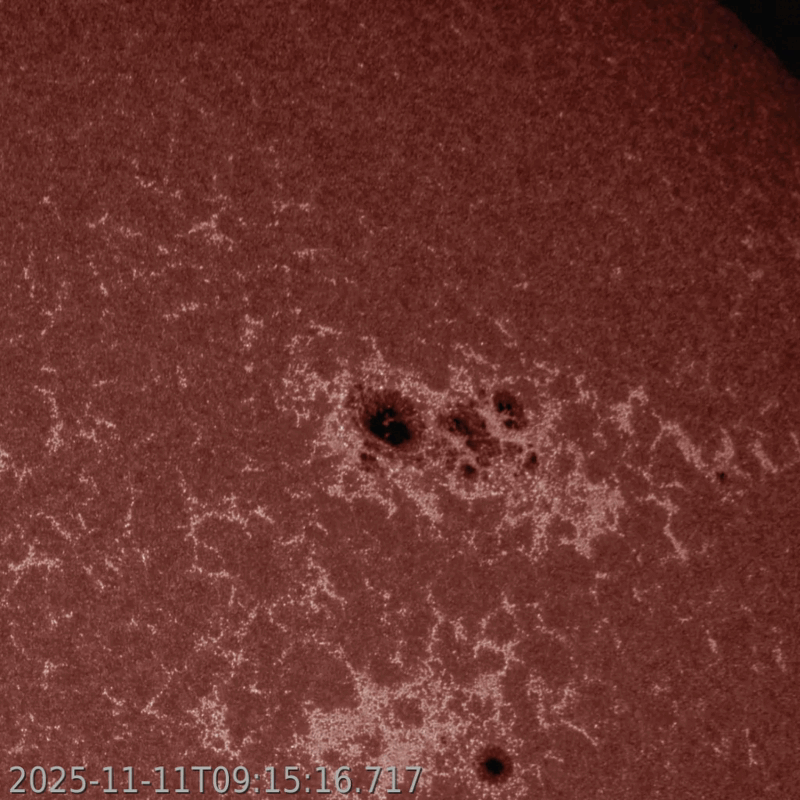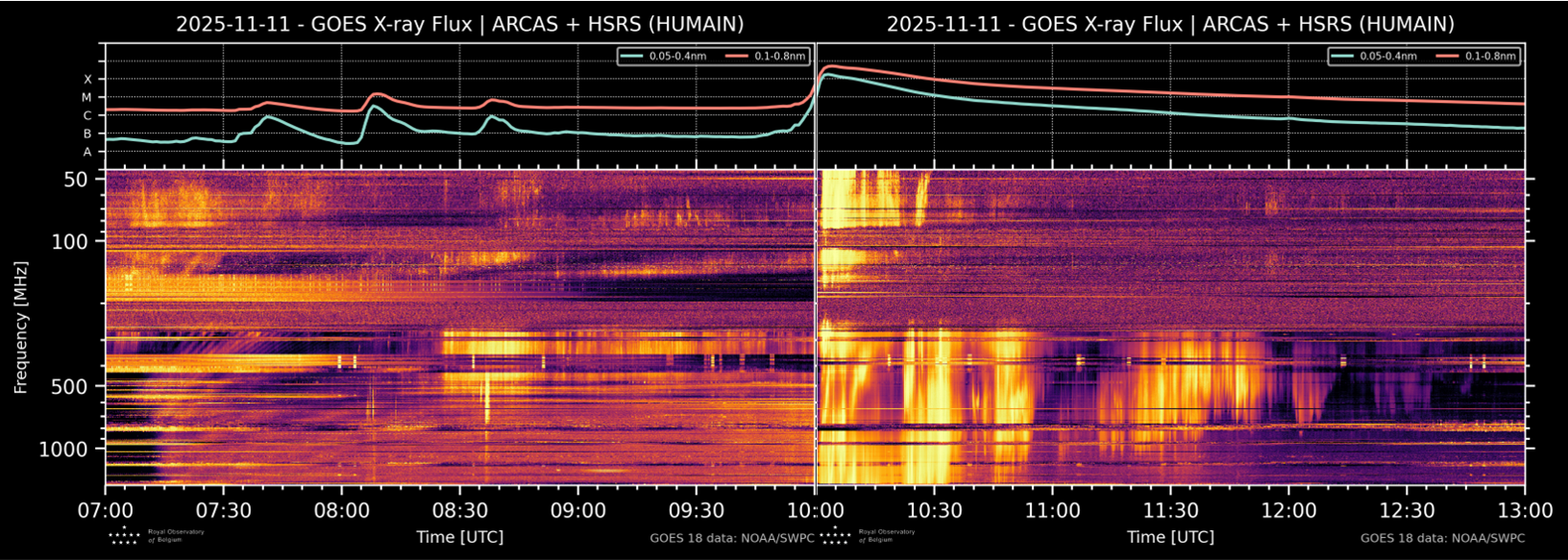The Sun produced its 3rd X-class event in as many days. The source was again SIDC Sunspot Group 687 (NOAA active region (AR) 4274). This region has now produced 4 X-class events (see this STCE news thread for a discussion on the previous events), and today's flare was the strongest so far: an X5.1 peaking at 10:04UTC. This is the strongest flare so far in 2025, and currently ranks 6th in the strongest flares of the current solar cycle. As with the previous flares in NOAA 4274, the location was to the southeast of the main (trailing) sunspot. This can be seen in the SDO/AIA1700 clip underneath, showing the lower solar atmosphere in far unltraviolet (FUV) and allowing to see the largest sunspots.

This large sunspot group still contains a very complex structure as can be seen in the comparison underneath, showing the region in white light (left; SDO/HMI), its magnetic structure (middle; blue and red denote opposite magnetic polarities), and the FUV image at the time of the flare's peak (right). In view of its size and magnetic complexity, it is very likely that NOAA 4274 will continue to produce more strong flares over the next few days.

The flare is associated with a still ongoing proton event that started at 09:55 UTC with the flux of protons with energies of 10 MeV or more reaching a preliminary maximum of 156 pfu today at 14:00 UTC (GOES). This would classify as a moderate solar radiation storm on the NOAA scales ("S2"). This is the strongest proton event associated with any of the eruptions produced by NOAA 4247 so far. However, and contrary to the previous X-class events produced by NOAA 4274, the flux of protons with energies of 100 MeV or more also increased (see this comparison for the last 3 X-class flares). The greater than 100 MeV is currently at 26 pfu and still increasing, whereas the 500 MeV flux reached a maximum of almost 3 pfu at 12:10UTC. As a result, neutron monitors on the ground recorded a ground level enhancement (GLE), i.e. an increase in the background radiation. There have been only 4 such GLEs so far this solar cycle, and today's one clearly outperforms them by a factor 3 to 7. GLE 77 was thus picked up by NMDB, a worldwide network of neutron monitors, showing a very obvious increase in the neutron count recorded by most stations (annotated chart). This was also the case for the Dourbes station (RMI) in Belgium (DRBS in the annotated chart). The effect of the energetic particles slamming onto the pxels of the coronagraph of SOHO can be seen in these images taken resp. just prior the flare's peak, and about 1 and 2 hours later.

Radio bursts were detected by the radio astronomy station at Humain (HuRAS), recording Type II, Type III and Type IV radio bursts (see the STCE SWx Classification page) , as shown in the radio spectrogram underneath with the horizontal axis representing time and the vertical axis representing frequency (lowest frequencies on top). The top chart represents the evolution of the soft x-ray flux as recorded by GOES. A zoom on the 25-75 MHz band between 10:00 and 10:30 UTC is provided by the HuRas/SPADE instrument.
The intensity of the radio bursts was very pronounced at ultrahigh frequencies (UHF ; 300 - 3000 MHz), the burst peaking at 53.000 sfu at GNSS frequencies (1415 MHz ; NOAA/USAF). The intensity at the latter frequency was the strongest radio burst of all eruptions produced so far by NOAA 4247, and may have disturbed radio communications and applications at these frequencies.

The X-class flare affected the lower frequency portion of the High Frequency communication band (HF Com ; 3 - 30 MHz) on the dayside of the Earth, mainly over the middle and southern portion of Africa. An advisory to civil aviation has been issued (PECASUS). The ongoing proton event moderately affects the HF communications over the polar regions, in particular over Antarctica. The effects of the X5 flare and the proton event on HF Com can be seen in the D-RAP (NOAA/SWPC) maps underneath, resp. left and right.

Following the analysis of the related Type II and Type IV radio bursts, a coronal mass ejection (CME) with a shock speed near 1350 km/s was associated with this X5 flare (NOAA/USAF). The CME itself was much faster than the CMEs associated with the 2 previous X-class events, resp. near 650, 1150 and 1450 km/s plane-of-the-sky speed. See the "J-plots" from STEREO-A covering the east limb (annotated chart ; note the increasing slope of the consecutive lines indicating faster CMEs). Coronagraphic images (see above) show a halo CME associated with the X5 flare, meaning this one is heading straight to Earth. It remains to be seen when exactly this CME will arrive at the earth environment, but it will not catch up with the 2 previous CMEs. The latter two are currently expected to arrive early on 12 November. It remains uncertain if the CME from 10 November will catch up with the CME from 9 November. This can be seen in this EUHFORIA model (clip underneath ; annotated still ; ESA Swx portal). Note that the CME associated with today's X5 flare is not integrated in this run yet. Standing-by further analysis by the SIDC SWx forecaster. At any rate, moderate to severe geomagnetic storming (Kp = 6 to 8) can be expected, especially if the first two CMEs catch up and/or the north-south component of their magnetic field is directed southward. The 3rd CME may then disturb even further an already agitated geomagnetic field. If severe geomagnetic conditions are reached, then there's a chance on aurora over Belgium. Please stay tuned for further updates!






